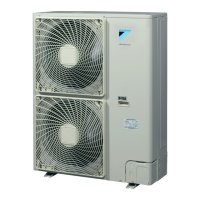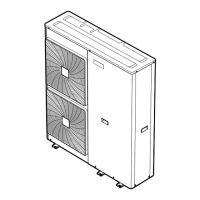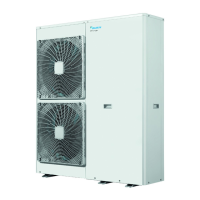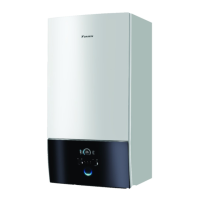8 Configuration
Installer reference guide
54
ERHQ+ERLQ011~016 + EHBH/X11+16CB
Daikin Altherma – Low temperature split
4P384974-1 – 2015.01
# Code Description
[A.2.2.6.3] [C-09] Alarm output
Indicates the logic of the alarm output on
the digital I/O PCB during
malfunctioning.
▪ 0 (Normally open)(default): The alarm
output will be powered when an alarm
occurs. By setting this value, a
distinction is made between
malfunctioning and detection of a
power failure of the unit.
▪ 1 (Normally closed): The alarm output
will NOT be powered when an alarm
occurs.
[A.2.2.6.4] [F-04] Bottom plate heater
Only applicable for EHBH/X11+16 and
EHVH/X11+16. Indicates if an optional
bottom plate heater is installed on the
outdoor unit. The power of the bottom
plate heater is in this case supplied by
the indoor unit.
▪ 0 (No)(default): NOT installed.
▪ 1 (Yes): Installed. Remark: If this
value is set, the output on the digital I/
O PCB cannot be used for space
heating/cooling output. See
"5Application guidelines"on page11.
Alarm output logic
[C-09] Alarm No alarm No power
supply to unit
0 (default) Closed output Open output Open output
1 Open output Closed output
Demand PCB
The demand PCB is used to enable the power consumption control
by digital inputs. See "5Application guidelines"on page11.
# Code Description
[A.2.2.7] [D-04] Demand PCB
Only applicable for EHBH/X04+08 and
EHVH/X04+08. Indicates if the optional
demand PCB is installed.
▪ 0 (No)(default)
▪ 1 (Pwr consmp ctrl)
Energy metering
When energy metering is performed by the use of external power
meters, configure the settings as described below. Select the pulse
frequency output of each power meter in accordance with the power
meter specifications. It is possible to connect (up to 2) power meters
with different pulse frequencies. When only 1 or no power meter is
used, select No to indicate the corresponding pulse input is NOT
used.
# Code Description
[A.2.2.8] [D‑08] Optional external kWh meter1:
▪ 0 (No): NOT installed
▪ 1: Installed (0.1pulse/kWh)
▪ 2: Installed (1pulse/kWh)
▪ 3: Installed (10pulse/kWh)
▪ 4: Installed (100pulse/kWh)
▪ 5: Installed (1000pulse/kWh)
# Code Description
[A.2.2.9] [D‑09] Optional external kWh meter2:
▪ 0 (No): NOT installed
▪ 1: Installed (0.1pulse/kWh)
▪ 2: Installed (1pulse/kWh)
▪ 3: Installed (10pulse/kWh)
▪ 4: Installed (100pulse/kWh)
▪ 5: Installed (1000pulse/kWh)
8.2.4 Quick wizard: Capacities (energy
metering)
The capacities of all electrical heaters must be set for the energy
metering and/or power consumption control feature to work properly.
When measuring the resistance value of each heater, you can set
the exact heater capacity and this will lead to more accurate energy
data.
# Code Description
[A.2.3.1] [6-02] Booster heater: Only applies to domestic
hot water tanks with an internal booster
heater (EKHW). The capacity of the
booster heater at nominal voltage.
Default: 0kW.
Range: 0~10kW (in steps of 0.2kW)
[A.2.3.2] [6-03] BUH: step 1: The capacity of the first
step of the backup heater at nominal
voltage. Default: 3kW.
Range: 0~10kW (in steps of 0.2kW)
[A.2.3.3] [6-04] BUH: step 2: Only applies to a two-step
backup heater (*9W). The capacity
difference between the second and first
step of the backup heater at nominal
voltage. Nominal value depends on the
backup heater configuration:
▪ 3kW, 1N~ 230V: 0kW
▪ 6kW, 1N~ 230V: 3kW (6kW-3kW)
▪ 6kW, 3~ 230V: 3kW (6kW-3kW)
▪ 6kW, 3N~ 400V: 3kW (6kW-3kW)
▪ 9kW, 3N~ 400V: 6kW (9kW-3kW)
Range: 0~10kW (in steps of 0.2kW):
▪ *3V: default 0kW
▪ *9W: default 6kW
[A.2.3.6] [6-07] Bottom plate heater: Only applies to an
optional bottom plate heater
(EKBPHTH16A). The capacity of the
optional bottom plate heater at nominal
voltage. Default: 0W.
Range: 0~200W (in steps of 10W)
8.2.5 Space heating/cooling control
The basic required settings in order to configure the space heating/
cooling of your system are described in this chapter. The weather-
dependent installer settings define the parameters for the weather-
dependent operation of the unit. When weather-dependent operation
is active, the water temperature is determined automatically
depending on the outdoor temperature. Low outdoor temperatures
will result in warmer water and vice versa. During weather-
dependent operation, the user has the possibility to shift up or down
the target water temperature by a maximum of 5°C.
See the user reference guide and/or operation manual for more
details about this function.

